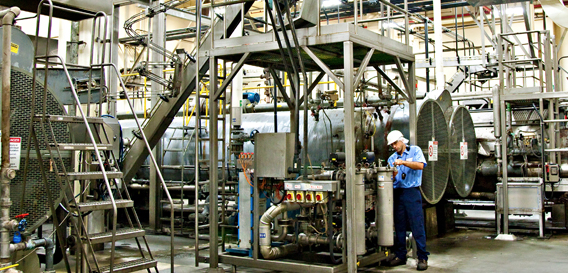Nestlé to Transform Milk Factory to ‘Zero Water’ in California
Published 05-13-15
Submitted by Nestlé S.A.
 Inside the Nestlé USA milk factory in Modesto, California, in the United States.
Inside the Nestlé USA milk factory in Modesto, California, in the United States.Nestlé is investing in innovative technology to help reduce the amount of water it uses in California at the five water bottling plants and four facilities where food or petcare products are manufactured.
“Technology we have already deployed successfully elsewhere in the world to help address the challenges of water scarcity will improve our water use efficiency, relieving pressure on California’s water resources,” says Nestlé’s Head of Operations José Lopez.
Last year in Mexico, Nestlé opened its first ‘zero water’ plant, which extracts all the water it needs from milk used to manufacture dairy products.
Work is underway to transform the Nestlé USA milk factory in the city of Modesto into a ‘zero water’ factory, meaning the plant will not use any local freshwater resources for its operations.
The project should save nearly 63 million gallons (238,000 cubic meters) of water each year, equivalent to 71% of absolute withdrawals in 2014.
Around $7 million has been invested in the project which is due to be completed by the end of 2016.
At the Nestlé USA factories in Bakersfield and Tulare savings of more than 26 million gallons (100,000 cubic meters) of water each year have been identified, potentially reducing the plants’ absolute annual withdrawals by 12% compared to 2014 levels.
And planned investments this year in conservation measures to reduce the amount of water used in Nestlé Waters’ bottling plants in California are projected to save 55 million gallons of water (208,000 cubic meters) a year, a reduction of nearly 8% compared to 2014 levels.
Further measures to reduce potential water wastage at these plants are under consideration, and as these are identified there will be further updates.
Technological solutions
Nestlé uses a phased approach to reduce water in its factories.
First, engineers look for ways to optimize the processes.
Second, they look for opportunities to reuse the water, for example using cooling water in vacuum systems.
In the third phase, such as in the zero-water factory, they deploy innovative methods to extract water from raw materials and then recycle it.
In California Nestlé will apply a methodology called ‘Water Target Setting’ which not only identifies opportunities to reduce water usage but also the most appropriate technology to be implemented.
This approach has been used in more than 80 factories worldwide, identifying opportunities to reduce water usage by 10%-30% depending on the location.
For example at a Nestlé factory in the UK an anaerobic digestion system which converts solid and liquid sewage waste into clean water and natural gas has reduced the plant’s water footprint while at the same time cutting the amount of greenhouse gases emitted, and reducing solid waste significantly.
Going further
Nestlé is carrying out assessments of its facilities in California as part of an ongoing effort to improve operational performance and the impact of its plants on the watersheds in which they operate.
The state of California uses nearly 50 billion cubic metres (13 trillion gallons) of water a year, of which Nestlé’s nine plants use less than 4 million cubic metres (1 billion gallons).
“Our water bottling operations in California have come under increased scrutiny in recent weeks,” says Mr Lopez.
“We are focused on how to adapt our bottling and our manufacturing operations, and our supply chain, to make them more resilient and more resistant to drought conditions,” he says. “We will test innovative solutions, prove they are efficient and effective and will share what we learn with others.”
The World Resources Institute is helping Nestlé to better understand water risks to the company’s food and bottled water manufacturing operations in their localities and to identify water stewardship opportunities.
Work is also underway to implement the Alliance for Water Stewardship (AWS) international standard in each of Nestlé’s nine California factories, within two years.
The standard is a set of rigorous criteria for how water should be managed in a way that is environmentally, socially, and economically beneficial.
These efforts represent Nestlé’s long term commitment to the state of California.
Water use reduction targets
Globally, Nestlé has already cut its total water withdrawal in absolute terms by almost one-third over the past 10 years, and has publicly committed to do more.
It aims to reduce its withdrawal per tonne of product by 40% by 2015, compared to 2005.
It currently has 376 water-saving projects underway in its factories worldwide, which are projected to save around 1.84 million cubic metres of water this year.
About Nestlé in the United States
Nestlé in the United States is committed to being a trusted leader in nutrition, health and wellness. Our diverse portfolio of food and beverage products provide nutritious options for every member of the family, including infants, toddlers, teens and adults, mature adults, and dogs and cats. Nestlé in the U.S. consists of seven main businesses: Nestlé USA, Nestlé Purina PetCare Company, Nestlé Waters North America, Nestlé Nutrition, Nestlé Professional, Nespresso and Nestlé Health Science. Together, these companies operate in more than 120 locations in 47 states and employ over 51,000 people. The United States is Nestlé S.A.'s largest market with combined product sales in the United States totaling more than $26 billion in 2014.


